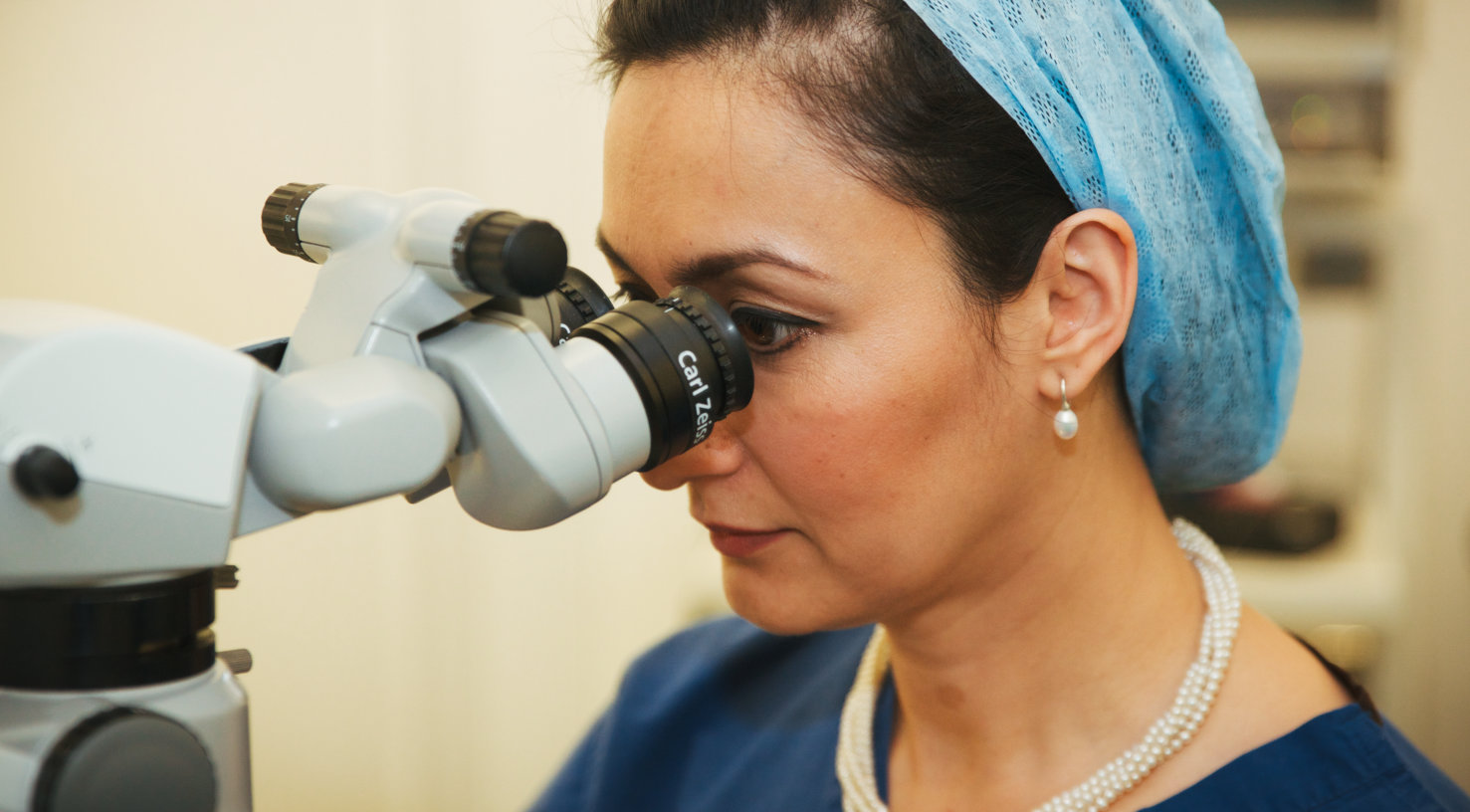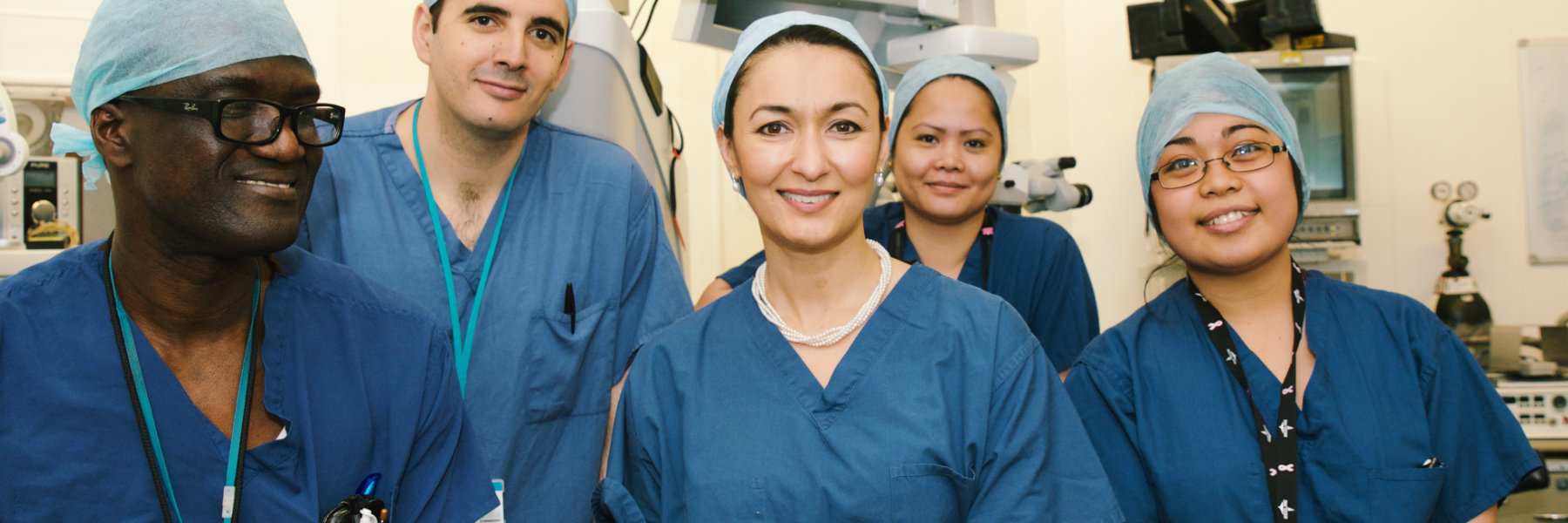Vitrectomy Surgery
What is a vitrectomy operation?
A vitrectomy operation is an operation inside the eye, which is done through three small keyhole incisions made on the white of the eye. The vitreous gel in the back half of the eye is removed as part of the surgical treatment of a range of conditions such as retinal detachment, macular holes, epiretinal membranes, vitreous haemorrhages and advanced complications of diabetic eye disease. Your eye does not need the vitreous gel, and does not replace or regrow it. At the end of the operation, it will be replaced with a balanced salt solution, a gas bubble or an oil bubble. The role of the gas or oil bubble is to ‘tamponade’, or hold the layers of the retina in place to secure the retina in the post-operative period. Balanced salt solution and gas bubbles will be gradually replaced with an aqueous fluid produced naturally by the inside of the eye. Usually this fills just the front part of the eye, the anterior chamber, but after vitrectomy it fills the whole eye. I will explain each of these next.
Bubbles (Tamponade agents) and post-operative posturing
When the vitreous gel is removed it is replaced with saline fluid, gas or oil, and the next section tells you about these and about posturing that you may be required to adopt for a few days after surgery. Not all patients need to posture after vitrectomy surgery and you will be given information on posturing before you are discharged from the hospital.
Gas bubble
Some vitrectomy operations require a gas bubble in the eye at the end of surgery. Some conditions, such as macular holes and retinal detachments routinely need a gas bubble, but a vitrectomy for any condition may require a gas bubble, and the decision is made during the operation if there is a tear in the retina during surgery.
The role of the gas bubble is to hold two layers of the retina together whilst the necessary sealing takes place. The principle is similar to when you want to stick 2 sheets of paper together, and you put them between two books to hold the wet sides together till the glue dries. The gas bubble floats upwards and holds the two layers of torn retina together until the sealing treatment takes effect – this usually takes about 5 to 7 days. Because the gas always floats upwards, the tear will be supported in the upright position if it is at the top of the eye, but if the tear is on the side, you will be asked to adopt a posture on one side or the other to bring the tear into a the right position for the gas bubble to hold the retina together.
There are two types of gas bubble I generally use, a shorter acting gas, sulphur hexafluoride (SF6), which lasts from 2 to 4 weeks, and a longer acting gas, perfluoropropane (C3F8), which lasts between 4 to 8 weeks. A gas bubble will gradually dissolve over the next few weeks and disappear – you will have poor vision in the eye whilst it is full of gas, and over the following days and weeks you will recover the vision as the gas bubble gets smaller, starting with the top of your vision.
You must not travel by air or to high altitude for as long as there is a gas bubble in your eye.
This may be anything from 2 weeks to 8 weeks, and therefore I generally advise not to plan any air travel in the weeks after vitrectomy surgery as a precaution. If air travel is absolutely necessary we can use silicone oil instead – see below.
If you later need a general anaesthetic whilst you have gas in the eye you must inform the anaesthetist as the gases used for general anaesthesia may need to be changed.
Silicone Oil bubble
In some cases an oil bubble is used instead of a gas bubble, usually if there is already scarring in the retina, which will need to be held in place for longer than can be achieved by a gas bubble. An oil bubble does not dissolve and go away on its own, it needs a second (smaller) operation to remove it about 3 to 4 months later. Sometimes, an oil bubble can be used instead of a gas bubble if the surgery is essential, but there are air travel needs that cannot be delayed.
Balanced Salt Solution
If you do not need either gas or oil you will have a balanced salt solution in the eye to replace the vitreous gel. This will be gradually replaced with an aqueous fluid produced by the inside of the eye, and you should follow the advice in the general advice section. You will have no particular requirements for posturing and there are no restrictions on air travel or travelling to high altitudes.
Post-op Posturing
If a gas or oil bubble has been used as part of your vitrectomy surgery, you will need to posture for 5 to 7 days from the time of surgery. You will be given on instructions on what position to assume. You will need to posture for 45 minutes in every hour, and you can be up and about normally for 15 minutes every hour. Posturing needs to be maintained overnight as well, and you will have advice on which position to lie in when you sleep. The commonest positions are one or other cheek to the pillow, or ‘face down’. For ‘face down’ posturing, I do not require you to lie flat on your stomach, but recommend and ‘eyes down’ position, as if you are reading a book in your lap.
You will receive the correct posturing advice for you after surgery.
Even if some of these are affecting one eye you may feel you can manage because the vision is better in the other eye. It is fine to leave cataract surgery and rely on the better eye for as long as you are comfortable with this, unless the cataract is very advanced and you have severe loss of vision – your eye examination will help make a decision.
You may be advised to have cataract surgery if you have a sight threatening retinal condition but the cataract is interfering with my ability to examine the back of the eye. In this case, I will advise you to consider cataract surgery if I feel that there is a risk of you losing vision if I am unable to monitor or treat the retina adequately.
If you are a driver and your vision does not meet the DVLA standards for driving (read a number plate from 20m, see Driving Eyesight Rules) I will usually recommend cataract surgery if you wish to continue driving. In milder cases you can see your optician first because a change in glasses or contact lenses may improve the vision to legal driving standards for a year or two, but you will need to keep checking to be sure you are legal for driving. You need to be able to read a number plate made after 2001 at 20m in daylight with your glasses or contact lenses if you use them. Your visual acuity must be 6/12 or better and you need an adequate field of vision.
When to seek further advice

All operations carry a risk of complications either during or after surgery. One of the most important complications is infection, although the risk is very low at less than 1 in 500. Infections can be treated with prompt antibiotics. Your eye will usually be red and uncomfortable immediately after surgery, and this is to be expected, but you should contact us if you notice any of the following:-
· Increasing pain
· Increasing redness
· Worsening vision
If you have had a gas or oil bubble in the eye I will have checked the pressure in the eye in the days after surgery. Sometimes, the pressure is normal in the first 24 to 48 hours but becomes high in the following few days. High pressure in the eye may cause pain in and around the eye, and you will need to be seen for a repeat pressure check. If the pressure is high it usually responds very well to some additional eye drops that bring the pressure down, and you will be prescribed these for a few weeks.
General precautions after all operations
· Use your drops as prescribed. Please do arrange for help with eye drops after your operation if you do not feel you can put them in yourself.
· Cleanse the eye gently with boiled, cooled water.
· Avoid rubbing the eye.
· Do wear the eye shield at night for the first few nights, as it will reduce the risk of accidentally rubbing the eye in your sleep.
· You can be as mobile as you feel comfortable with, but do remember that you have had a big operation and you may feel tired.
· Do not drive in the first few days after surgery as you may not have clear vision with both eyes open and your judgement of distances and your awareness in your peripheral vision may be impaired.
· You may use your vision as much as is comfortable.

Anaesthesia for vitrectomy surgery
Most vitrectomy surgery can be done with just local anaesthetic, using either a blunt cannula or needle injection to numb the eye (you will be awake during surgery).
Some patients are not good candidates for local anaesthesia – either they are unable to lie still for the required time, or they are very nervous or simply have a fear of being awake whilst they have an eye operation. In such situations I can arrange for you to have general anaesthesia as long as your general health can tolerate it – the decision is one that we make with the anaesthetist looking after you to make sure you are safe at all times.
You also have the option of having light sedation instead of full general anaesthesia, which is often very helpful and patients prefer this to a full general anaesthetic.
How long do I have to stay in hospital for vitrectomy surgery?
Vitrectomy surgery is usually done as a daycase procedure under local anaesthesia. it can take 1-2 hours, This means that you will be in hospital for several hours, and can go home the same day. Often, patients can also go home the same day after general anaesthesia, but this depends on how well you recover.